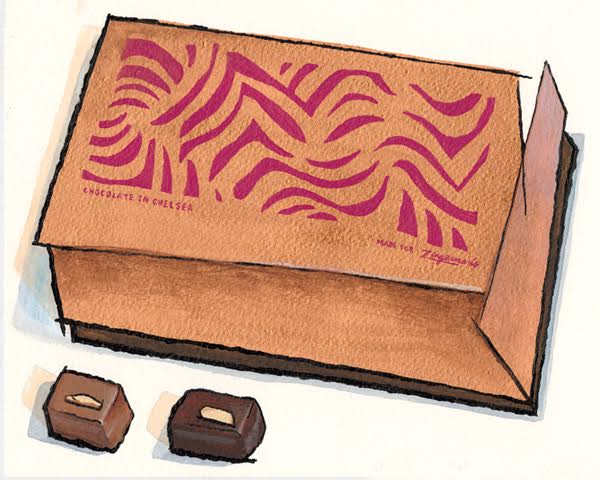To make chocolate truffles, you start by making ganache. What is ganache? When you eat a truffle that has a hard chocolate shell around a soft chocolate inside—that soft inside is ganache. Ganache is an emulsion of chocolate and cream. You make it by mixing solid chocolate into just-boiling cream. The emulsion is key: if you just take chocolate and mix it into hot cream, you get hot liquid chocolate. If you let it cool down, you get cold liquid chocolate. But when you let ganache cool down, you have a rich, super thick, creamy chocolate that’s magically suspended somewhere between solid and liquid.
When you emulsify something, you’re mixing two liquids together that usually won’t mix, like water and oil. Mayonnaise is the classic example, where oil and an acid like vinegar are mixed together into a thick, creamy paste with the help of an egg yolk that allows them to bind together. To get a good emulsion of chocolate in cream, you’ve got to be careful about mixing at the right temperatures and using the right method.
For a chocolatier, making the ganache isn’t necessarily the hard part. It’s keeping the ganache that gets tricky. Think about it: ganache is made of cream. If you let cream sit around on the counter, it’s going to spoil—or, at the least, it’ll dry out. Mixing it with chocolate extends the shelf life, but only by a few weeks. To get chocolates that last for months on the shelf at the mall, you have to add other things, too. The simplest is lots of sugar. Booze is another way to extend the shelf life. And of course, you could always just add preservatives. But sugar or booze or preservatives are all going to affect the flavor of the truffles—and probably not for the better. They end up way too sweet, or too pungent, or too chemical-y.
In order to have a box of chocolates that tastes great, you have to be really careful to keep the flavors in balance. That’s what chocolatier Cathy Selin of Chocolate in Chelsea does. She’s fastidious with her flavors, making sure that the chocolate is never overpowered by too much sugar or other flavors. When you eat her chocolates, the primary thing you taste is really, really good chocolate.
How to make a normal box of chocolates.
You start by choosing the chocolate to use. That choice has an enormous impact. Have you ever tried 100% cacao baking chocolate? It usually tastes terrible—unpalatably bitter. You have to add a lot of sugar to it to make it taste okay. I used to think that’s just how cacao tasted until I had really good 100% cacao chocolate. The reality is that it tastes bad because it’s made with really poor quality cacao beans. What big chocolate makers like about those beans is that they are cheap, and sugar is even cheaper, and if you add a lot of sugar to bad cacao you can cover up a lot of the bad flavors. But you’re never going to get flavor as good as you would if you used really good cacao. (It’s the same thing as with coffee—if you start with bad coffee beans, you’re never going to have an extraordinary cup of coffee, no matter how much fancy creamer you pour into it.)
That’s how most chocolate makers make a normal box of chocolates. They start with cheap chocolate. They mix it with too much sugar to try to cover up off flavors and extend the shelf life. They put it in a gorgeous box and jack up the price. And then we get to consult that accordion sheet that has all the pictures and descriptions of the chocolates and play the game of guessing which ones are good.
Or—you could just go for a box of not-so-normal chocolates.
The chocolates from Chocolate in Chelsea are anything but normal.
Cathy starts with dark chocolates from respected French chocolatiers Valrhona and Cluizel. To make her ganache, she mixes the chocolate with really good organic cream. She’s incredibly particular about the details: she could tell you all about the exact angle to hold your spoon at when you stir together your ganache, or about the viscosities of different chocolates and how that affects their ability to coat the outside of a truffle, or about the six different fat crystals in chocolate and how to temper them to get that perfect snap to the outside chocolate shell. When she develops a new recipe, it takes her months—sometimes years—to get the flavors and textures just right.
And boy does it show. Her pralines, filled with a mix of half almond/half chocolate and topped with a slivered almond, are a dense, silky wonder that melt slowly on your tongue into a nutty puddle. Her burnt sugar caramels are perfectly balanced. Her chocolates are never too sweet, and the flavors are spot on. There’s no guessing which chocolates are the good ones in this box; both the pralines and the caramels are really, really good. The shelf life is only a few weeks, but they’re so scrumptious I’d be shocked if the box made it that long.

